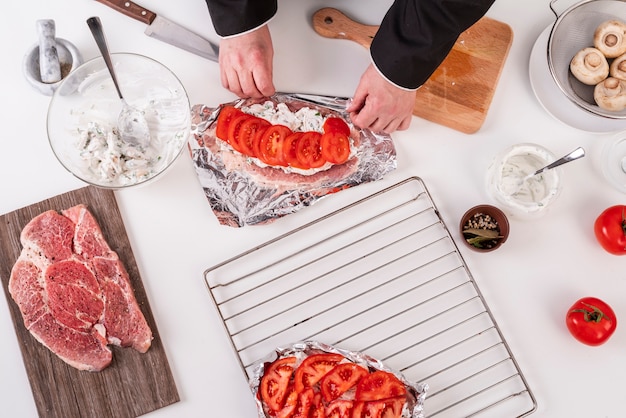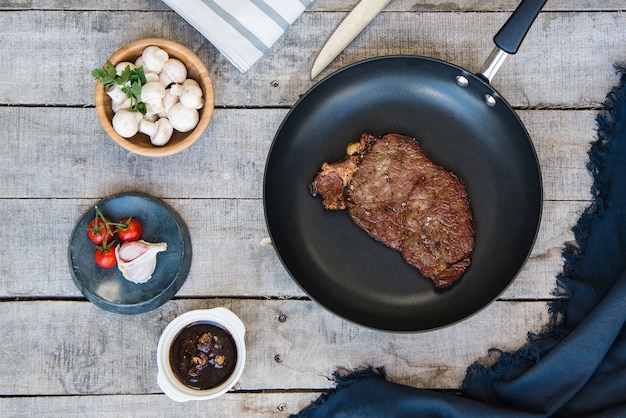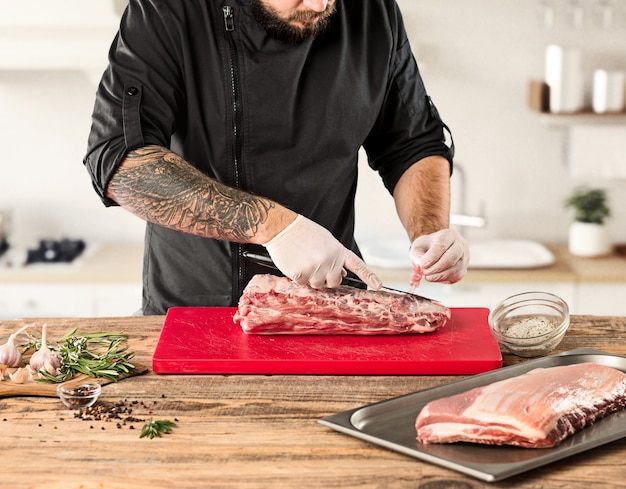Let's talk tenderloin, shall we? It's the crème de la crème of beef cuts, isn't it? Just thinking about that melt-in-your-mouth texture, bursting with flavour, makes me feel like I've arrived at a culinary destination. But, like any good thing, it needs a bit of TLC to bring out its best. And that's where I come in. I've spent years perfecting my tenderloin game, from choosing the right cut to nailing the perfect sear. And I'm ready to share all my secrets with you, my friend. Get ready, because we're about to embark on a culinary adventure that'll make your tastebuds sing!
Part 1: Choosing the perfect tenderloin

A Quick Look at Tenderloin
Tenderloin, you see, is the most tender cut of beef. It comes from the muscle that runs along the backbone of the animal. This means it's naturally lean, with very little marbling. But here's the thing, it's not the most flavorful cut. That's why it's often sold as a whole piece and doesn't usually have much fat on it. Don't worry though, we can still get some serious flavour going!
Finding the Right Cut
First things first, you need to find a tenderloin with a nice, even thickness. A thick tenderloin will cook more evenly and will be less prone to drying out. And when I say thick, I mean at least an inch, if not more. And, of course, it's got to be fresh. I'm talking about bright red colour, firm to the touch, and no funny smells. A good butcher will know their stuff and can guide you.
Beyond the Basics: Grading and Marbling
Now, you might have heard about beef grading systems. It’s a way to judge the quality of the meat based on factors like marbling (the amount of intramuscular fat). For tenderloin, you'll often find it graded "Select" or "Choice" in the US. "Choice" is generally considered a good choice for a tenderloin, as it'll have a bit more marbling than "Select", contributing to juiciness. But remember, no matter the grade, it's all about the cut!
Part 2: Preparing the Tenderloin for Cooking

The Trimming Ritual:
Now, we need to prepare the tenderloin for its starring role. First, we're going to give it a good trim. This means removing any excess fat or silver skin. Silver skin is a tough, membrane-like layer that can be a bit chewy if you leave it on. So, using a sharp knife, carefully peel it away.
The Magical Salt Rub:
Once your tenderloin is looking trim and tidy, it’s time to get into the flavouring. I always start with a good salt rub. This helps to season the meat evenly and draws out some of the moisture, which will create a more concentrated flavour. I use a good quality sea salt, and I'm not afraid to be generous.
Beyond Salt: Experimenting with Flavors
While a simple salt rub is a great starting point, feel free to get creative! Think about adding some freshly ground black pepper, garlic powder, or even a sprinkle of smoked paprika. These additions can really enhance the flavour of the tenderloin. For a bolder flavour, try a dry rub incorporating herbs like rosemary, thyme, or oregano.
Part 3: Cooking the Tenderloin – A Step-by-Step Guide

The Art of Searing:
Ok, the moment you've all been waiting for: the sear! This is where you're going to create that beautiful crust that's the hallmark of a perfect steak. I like to use a heavy-bottomed cast iron skillet for this, but a good quality stainless steel pan will work too. Get it super hot – I mean really hot. You should be able to feel the heat radiating from the pan.
Now, add a little bit of oil to the pan. I prefer to use a neutral oil like grapeseed or sunflower. Once it's hot, carefully place your tenderloin into the pan. Don't crowd the pan! Let it sear undisturbed for a few minutes until it’s beautifully browned on all sides. I'm talking about a nice, deep brown, not just a pale yellow.
Moving onto the Oven:
Now, it’s time to finish cooking the tenderloin in the oven. I like to cook it to medium-rare, but you can adjust the cooking time to your preference. Set your oven to 350 degrees fahrenheit. Transfer your seared tenderloin to a baking sheet and place it in the oven.
How long should you cook it? Well, that depends on the size of your tenderloin. A smaller tenderloin will cook faster than a larger one. For a 1.5-inch thick tenderloin, I recommend cooking it for about 15-20 minutes for medium-rare. For a 2-inch thick tenderloin, you'll want to cook it for about 20-25 minutes.
The Resting Ritual:
Once the tenderloin is cooked to your liking, take it out of the oven and let it rest for at least 10 minutes before slicing. This allows the juices to redistribute throughout the meat, resulting in a more tender and flavorful steak.
Part 4: Temperature Guide for Tenderloin
What’s Your Preferred Done-ness?
So, you want to know how to get that perfect level of “done-ness?” Here’s a handy-dandy guide to ensure your tenderloin hits the spot every time:
| Done-ness | internal temperature (°F) | Internal Temperature (°C) |
|---|---|---|
| Rare | 125-130 | 52-54 |
| Medium-Rare | 130-135 | 54-57 |
| Medium | 140-145 | 60-63 |
| Medium-Well | 150-155 | 65-68 |
| Well Done | 160 | 71 |
Now, you can use a meat thermometer to check the internal temperature of your tenderloin. But honestly, I find that the best way to judge doneness is by touch. A rare tenderloin will feel soft and squishy, while a medium-rare tenderloin will have a bit more spring to it. A medium tenderloin will feel firm but still springy, and a well-done tenderloin will feel very firm.
Part 5: Sauce Magic - Elevate Your Tenderloin
The Sauce is the Star:
You've got a beautiful piece of tenderloin, but now it's time to take it to the next level with a delicious sauce. There’s a whole world of sauces out there for tenderloin, so you can pick one based on your mood and the rest of your meal.
My Top Picks:
Here are a few of my go-to sauces that always hit the spot:
- Classic Béarnaise: This rich, creamy sauce, made with egg yolks, butter, and tarragon, is a classic for a reason. It adds a touch of elegance and a burst of flavour.
- Mushroom and Wine Sauce: This earthy, aromatic sauce is perfect for tenderloin. It's made with sautéed mushrooms, red wine, and a touch of cream. It's rich and decadent, and it goes wonderfully with the beefy flavour.
- Spicy chimichurri sauce: If you like a little heat, you'll love this fresh and vibrant sauce. It's made with parsley, garlic, red pepper flakes, olive oil, and vinegar. It adds a tangy, spicy kick to the tenderloin.
- Red Wine Reduction: For a simple yet elegant touch, a red wine reduction is always a winner. It adds a depth of flavour and a beautiful glossy finish.
Making Your Own Sauce:
Don't be afraid to experiment with your own sauce creations! You can use a simple pan sauce, made with the drippings from the tenderloin, or try a more complex sauce with herbs, spices, and even a touch of citrus.
Part 6: The Ultimate Sidekick for Your Tenderloin
The Perfect Pairing:
Of course, no epic tenderloin journey is complete without the perfect sidekick – the side dishes! I’m a big believer in keeping it simple with the sides, allowing the star of the show to shine.
My Side Dish Suggestions:
Here are some of my favourite side dishes that complement tenderloin beautifully:
- roasted asparagus: It’s simple, fresh, and full of flavour. The sweetness of the asparagus complements the rich flavour of the tenderloin perfectly.
- Creamy mashed potatoes: The classic pairing. The smooth, creamy texture of mashed potatoes is a perfect contrast to the tenderloin.
- Sautéed Spinach: A simple, healthy, and flavourful side dish. The spinach adds a touch of freshness and a burst of vitamins.
- Roasted Root Vegetables: For a hearty and comforting side, consider roasting root vegetables like carrots, parsnips, or potatoes.
- Polenta: The creamy texture of polenta is a beautiful contrast to the tenderloin, and it can be dressed up with herbs, cheese, or mushrooms.
Matching Your Side Dish to the Sauce:
Think about the overall flavour profile you're going for. A creamy béarnaise sauce might go well with a simple roasted vegetable medley, while a spicy chimichurri sauce might pair best with a lighter, more refreshing side like a salad or asparagus.
Part 7: Tips and Tricks for Tenderloin Success
Avoid Overcooking:
The biggest mistake people make when cooking tenderloin is overcooking it. Tenderloin is a very lean cut of meat, and it can quickly become dry and tough if you cook it for too long. Use a meat thermometer to check the internal temperature and take it out of the oven when it reaches your desired doneness.
Don't Be Afraid of Fat:
Tenderloin is a lean cut of meat, so a little bit of fat can go a long way in adding flavour and moisture. I like to sear the tenderloin in a little bit of butter or olive oil, and I’ll often add a pat of butter to the top of the tenderloin before it goes into the oven.
Rest is Key:
Remember to let your tenderloin rest for at least 10 minutes after cooking. This allows the juices to redistribute throughout the meat, resulting in a more tender and flavorful steak.
Don't Be Afraid to Experiment:
Tenderloin is a versatile cut, so don't be afraid to experiment with different cooking methods. You can try pan-searing and finishing in the oven, grilling it over medium heat, or even slow cooking it for a melt-in-your-mouth texture.
Part 8: FAQs - Your Tenderloin Questions Answered
1. What’s the best way to store tenderloin?
Tenderloin should be stored in the refrigerator, wrapped tightly in plastic wrap or placed in an airtight container. It can be stored for up to 3-5 days. For longer storage, you can freeze tenderloin for up to 3-4 months. Just make sure to wrap it tightly in plastic wrap and then in aluminum foil.
2. Can I cook tenderloin from frozen?
It's not ideal, but you can cook tenderloin from frozen. However, it will take longer to cook, and it might not cook as evenly. It’s best to thaw the tenderloin in the refrigerator overnight, then cook as directed.
3. What’s the difference between tenderloin and sirloin?
Tenderloin and sirloin are both cuts of beef, but they come from different parts of the animal. Tenderloin is a much more tender cut of meat than sirloin, and it's also more expensive. Sirloin is a more flavorful cut of meat, and it’s more affordable. Tenderloin comes from the muscle along the backbone, while sirloin comes from the loin, which is further down the animal.
4. Is tenderloin good for grilling?
Tenderloin can be grilled, but it's a little bit tricky because it can be prone to drying out. If you’re grilling tenderloin, make sure to cook it over medium heat and don't cook it for too long. You can also wrap it in foil towards the end of the cooking process to help keep it moist.
5. What’s the best way to slice tenderloin?
Tenderloin should be sliced thinly, against the grain. This will help to make the meat more tender and easier to chew. Use a sharp knife, and make sure to cut the slices evenly. If you're serving tenderloin as a main course, I recommend slicing it into 1-inch thick pieces.
There you have it. Your complete guide to conquering tenderloin beef. Remember, this isn't just about cooking meat; it's about creating a memorable experience. So, go forth, choose your perfect tenderloin, and get ready to impress!
Everyone is watching

Corn on the Cob: The Ultimate Guide to Perfectly Cooked Ears
Healthy MealsAh, corn on the cob. Just the name evokes images of sunny days, barbecues, and that sweet, juicy flavour that ...

Perfect Pork Roast Oven Cooking Time: A Guide to Delicious Results
Healthy MealsThere's something truly satisfying about a perfectly roasted pork. The aroma alone is enough to make your mout...

Ham Cooking Time: How Long to Bake, Smoke, or Boil a Delicious Ham
Healthy MealsAh, ham. It's a classic, isn't it? A real crowd-pleaser, especially around holidays. And when done right, it'...

Scallops: The Ultimate Guide to Perfect Cooking
Healthy MealsAh, scallops. Those delicate, sweet, and utterly delicious morsels of the sea. They hold a special place in my...

Spaghetti Squash: The Ultimate Guide to Cooking and Serving
Healthy MealsRemember that time you saw spaghetti squash at the supermarket, looking all bumpy and strange, and thought, "W...
